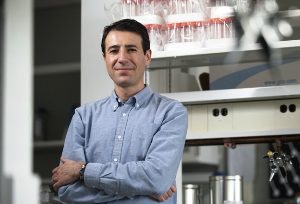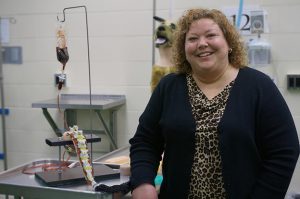Where discovery meets application, veterinary researchers and professionals break new ground in science, teaching, and clinical care.
Robert Abramovitch and Bea Biddinger are finding new ways to take big steps forward—one in tackling a global killer, and one in changing the way veterinary surgical procedures are taught. The two innovators from the College of Veterinary Medicine were recognized at the fourth annual MSU Innovation Celebration on April 16, 2014.
Robert Abramovitch: new strategies in the battle against TB

The award for Innovation of the Year went to Robert Abramovitch, associate professor in microbiology and molecular genetics, for his development of biosensors that detect latent tuberculosis (TB) and may help shorten the treatment time for TB and deter the emergence of drug-resistant TB. The World Health Organization ranks TB as second only to HIV/AIDS as the greatest killer worldwide due to a single infectious agent.
A signature feature of M. tuberculosis (Mtb), the bacterium that causes TB, is that it survives inside macrophages—the very cells that the immune system sends out to engulf and destroy bacteria. The biosensors will help Abramovitch's lab characterize how Mtb adapts to survive inside a macrophage as well as the genes and proteins that enable that adaptation.
Abramovitch's mission is to make discoveries that lead to new drugs to treat TB, particularly drugs that can shorten the treatment time for TB. That, in turn, may help reduce the emergence of drug-resistant strains of TB, which are encouraged with inconsistent dosing of antibiotics—a challenge to avoid with a six-month course of treatment.
A drug advance for this disease will make an enormous difference for the 8.6 million people who fall ill each year and the 1.3 million who die from TB.
Bea Biddinger: from the costume department to the surgery table

Bea Biddinger, manager of the College's Small Animal Teaching Lab, was recognized for her innovative creation and construction of animal models used for teaching veterinary students. She is designing and building silicone veterinary surgical models that allow veterinary students to learn and refine surgical skills before they conduct procedures on animals.
Since 2006, when Biddinger took on leadership of the Small Animal Teaching Lab, she has been looking for creative ways to provide students with experiences that foster exceptional surgical knowledge and skills. Developing better animal models for surgical training has been one component of Biddinger's mission.
The first training model Biddinger created was a synthetic cow tail that offered accuracy and realism for training students to draw blood. Blood is collected from cows' tails for laboratory analysis, including pregnancy testing. With Biddinger's tail model, students could be trained in blood drawing techniques, including locating the vein.
Now, to develop a broader range of teaching models, Biddinger has turned to silicon. She learned to work with silicon through training with stage makeup professionals, and is now creating models that will be used to teach a number of skills to students in the surgical lab. Because she is designing and building them herself, she is able to create very specific models—some of which may not exist commercially.
Pushing the boundaries of discovery
Abramovitch's and Biddinger's innovations exemplify the ways in which the College is setting the standard of excellence in veterinary medical education, scientific investigation, and clinical care. Collectively, we are pushing the boundaries of discovery to help transform the health and wellbeing of animals and humans, and forge new paths in educational technologies.
April 24, 2014
